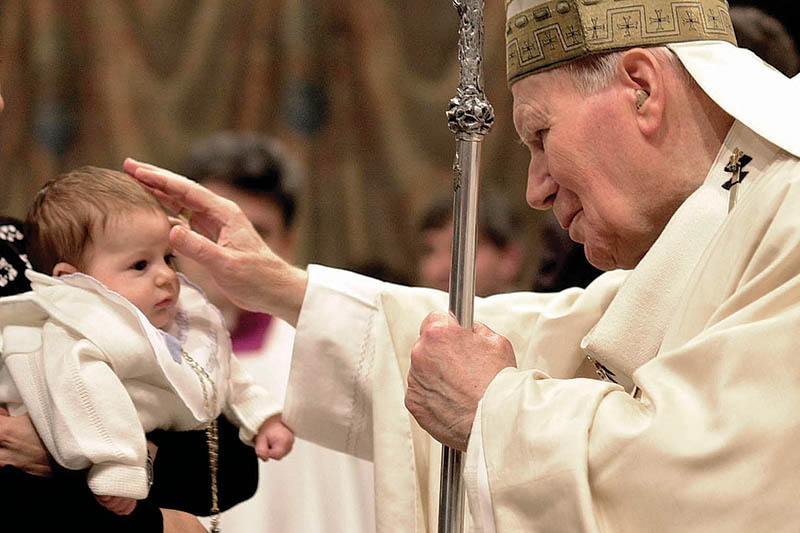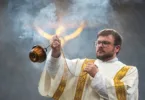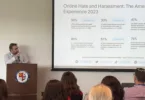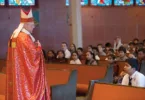
“Evangelium Vitae” (“The Gospeal of LIfe”), St. John Paul II’s landmark encyclical, celebrated its 20th anniversary on March 25. Photo from Catholic News Service.
St. John Paul II’s landmark encyclical celebrates 20 years
by Joe Bollig
joe.bollig@theleaven.org
KANSAS CITY, Kan. — You may not have read the encyclical, but no doubt you’ve heard two of the phrases it contains:
Culture of life.
Culture of death.
More than just labels, the two phrases are profound contrasting ideas. One is a critique of society, and the other is a proposition for a better future.
Those two ideas are embedded in “Evangelium Vitae” (“The Gospel of Life”), St. John Paul II’s landmark encyclical published on March 25, 1995, the solemnity of the Annunciation.
Pope Francis led the church in celebrating the 20th anniversary of the encyclical when he took part in an international vigil at the Basilica of Santa Maria Maggiore in Rome on March 24.
“It is a powerful, action-oriented plea to Catholics to build a culture of life,” said Ron Kelsey, archdiocesan pro-life consultant.
“I’ve always been impressed with the urgency that comes out of St. John Paul’s request to build a culture of life,” he continued. “And he really lays a lot of foundational issues for us in terms of how we build a culture of life and battle a culture of death.”
Kelsey’s copy of “Evangelium Vitae” is a small, blue book published by Pauline Books & Media. The pages are full of paper clips marking important pages. He constantly consults the encyclical.
John Paul II didn’t waste any time in communicating what the encyclical was about. It’s in the very first sentence: “The Gospel of life is at the heart of Jesus’ message.”
“We are made in God’s image, made to dwell with him eternally,” said Kelsey. “We are made to share his life. So, our earthly life is the beginning part of that eternal journey.”
John Paul II, who began to write the encyclical in 1991, was a witness to some of the greatest inhumanities of the 20th century — World War II, Nazism and communism.
And as pope, he witnessed other evils taking root in Western culture.
“It was written by St. John Paul II to respond to the challenges he recognized that the world and the church were facing in regard to the dignity of human life,” said Troy Hinkel, director of faculty of the archdiocesan-based Holy Family School of Faith Institute. “He wanted to respond and clear up some things with a lot of authority.”
In his encyclical, the late pontiff wanted to connect the dignity of human life — under assault by a variety of threats — with the essence of Jesus’ teaching. It is a mindset and mentality that infects and destroys cultures and societies.
“He summarized those dangers in the phrase ‘culture of death,’” said Hinkel. “The bottom line is, the ‘culture of death’ is any culture that thinks it can solve its problems by destroying humans, particularly innocent humans.”
“Evangelium Vitae” deals with abortion, immoral scientific experimentation on human embryos, use of fetal and embryonic tissue, euthanasia and capital punishment.
The Holy Father pointed to the source of this “culture of death” as coming from disconnects between life and freedom, and freedom and truth. Indeed, at the heart of the culture of death is a twisted idea of freedom that denies God.
The genius of the encyclical is it is easily understood and a useful synthesis of Catholic teaching.
“St. John Paul II didn’t say anything new,” said Father Anthony Saiki, associate pastor at Most Pure Heart of Mary Parish in Topeka. “What he did was consolidate all the church’s moral teaching about life and end-of-life issues and presented them in one concise document. I certainly use if for concise definitions and explanations of the church’s teachings.”
Even 20 years after the encyclical was promulgated, “Evangelium Vitae” retains its power.
“It is more relevant today than it was in 1995 when [Pope John Paul II issued] it,” said Father Saiki. “He was addressing issues of the day and different cultural trends that were alarming to him. But those threats and practices have only increased and compounded. Therefore, this ‘Gospel of Life’ is more relevant than ever.”
Hinkel agrees.
“It speaks the truth, and the truth — unlike [fashion] — is able to survive the vagaries of time without being impacted,” said Hinkel. “More specifically, the roots of the culture of death he identified are still among us, and the solution to those roots is still true — namely the gospel of life, preaching the life of Christ and the dignity of the human person.”
“What is urgently called for,” wrote the pope, “is a general mobilization of consciences and a united ethical effort to activate a great campaign in support of life. All together, we must build a new culture of life.”
Slowly and surely, that is what is happening, said Hinkel. The phrases “culture of life,” “culture of death,” and “civilization of love” have become part of the cultural lexicon. The pro-life movement is full of young people — and the numbers are growing.
At any given moment across the country and around the world, said Hinkel, Catholics are building a culture of life and a civilization of love with their prayers and actions.
“That’s a reality, and I see that as a result of this document and the witness of St. John Paul,” said Hinkel. “I see the civilization of love budding.
“It still has time to grow, but it’s budding.”






